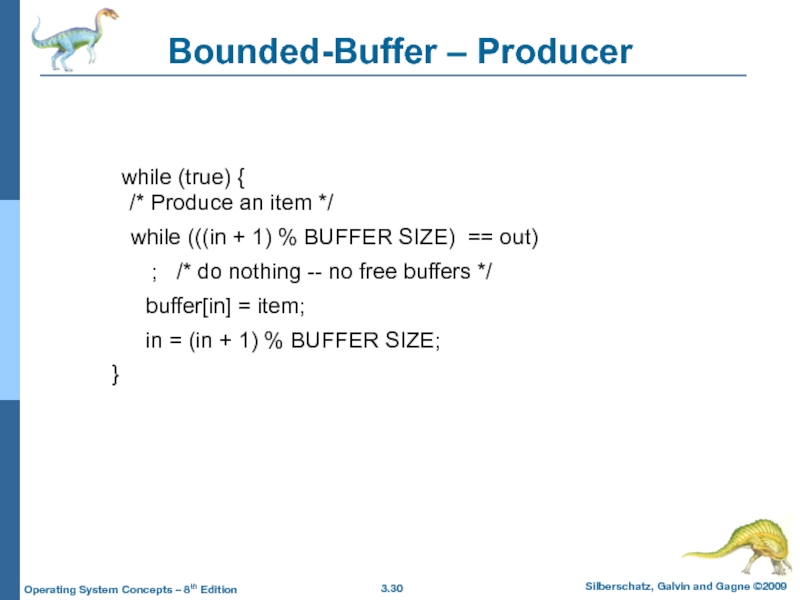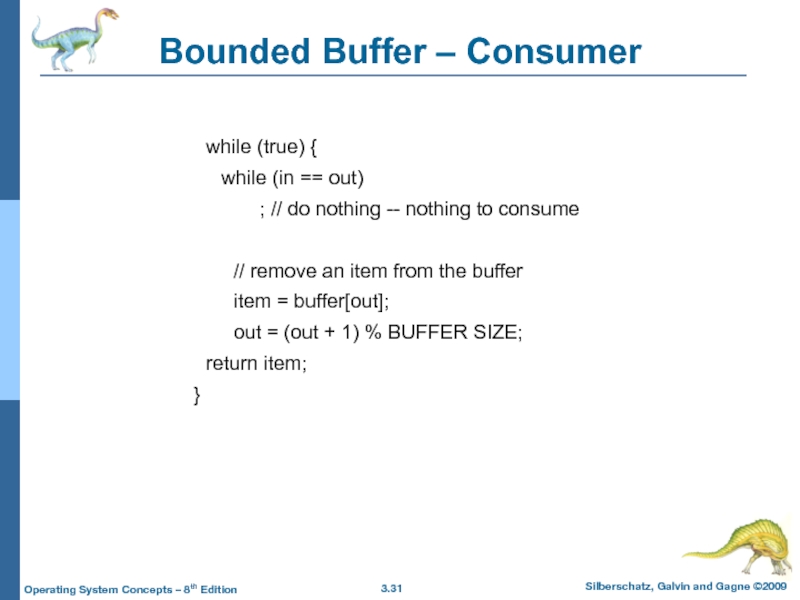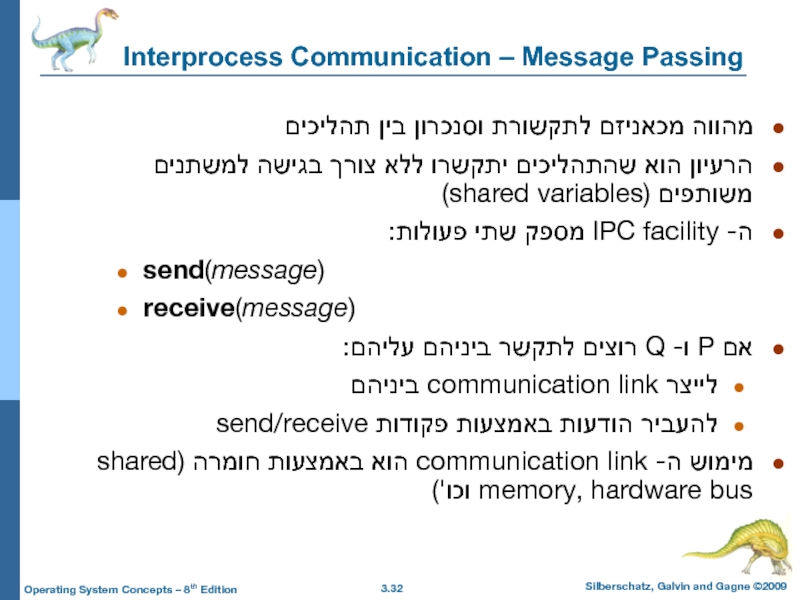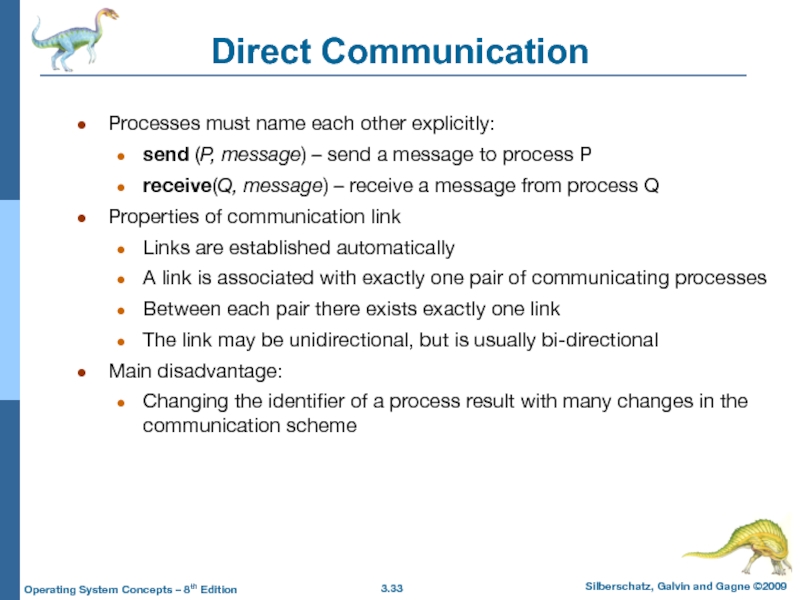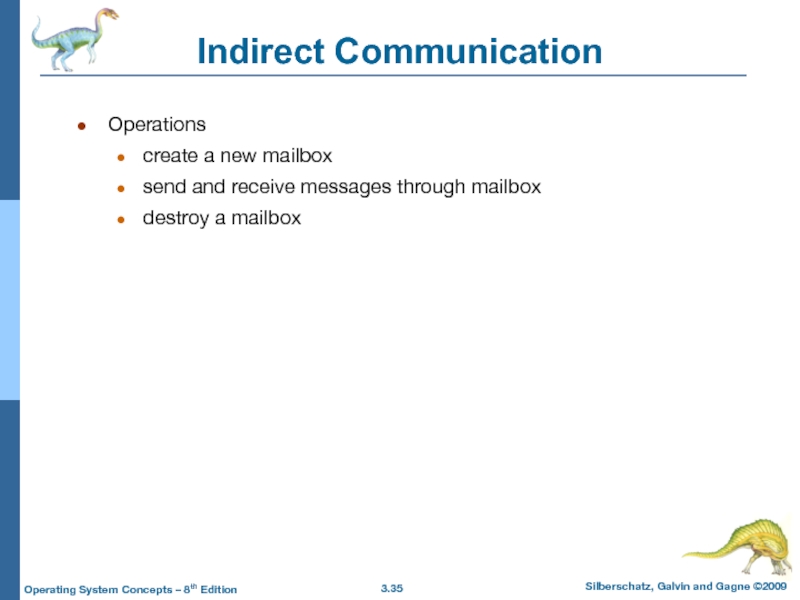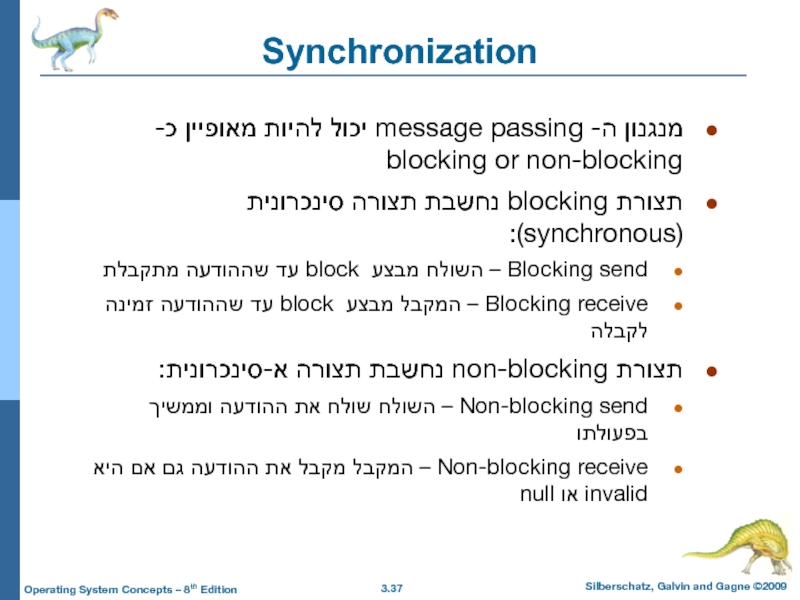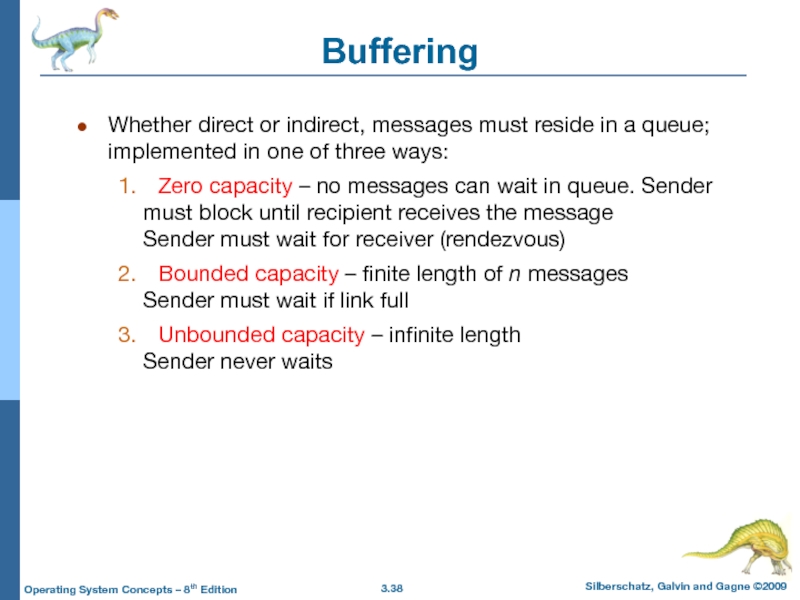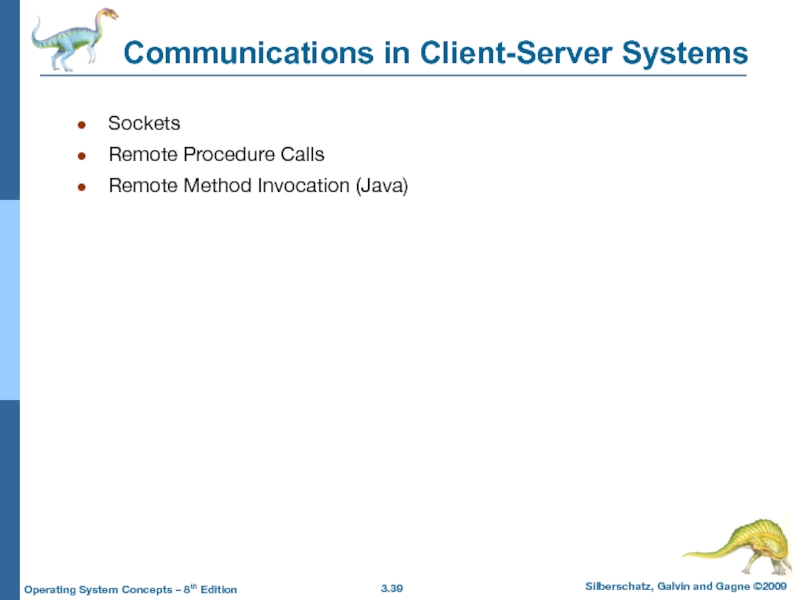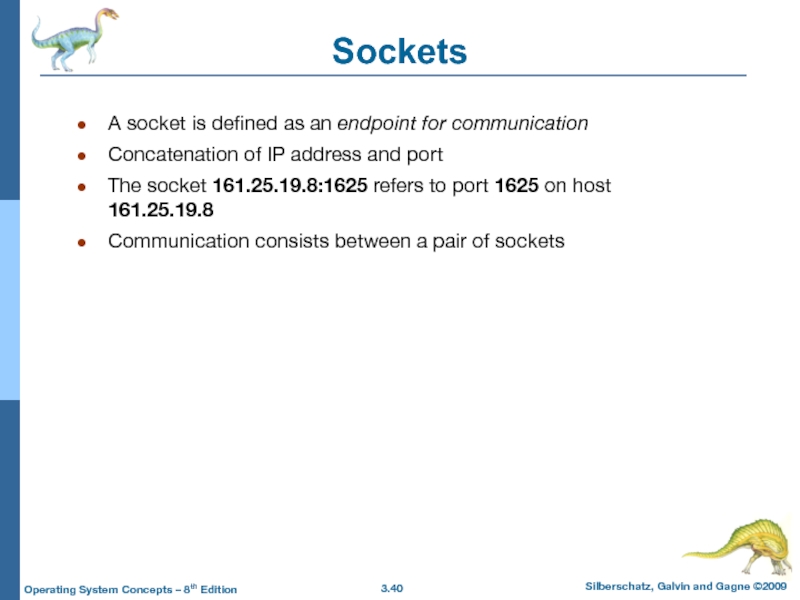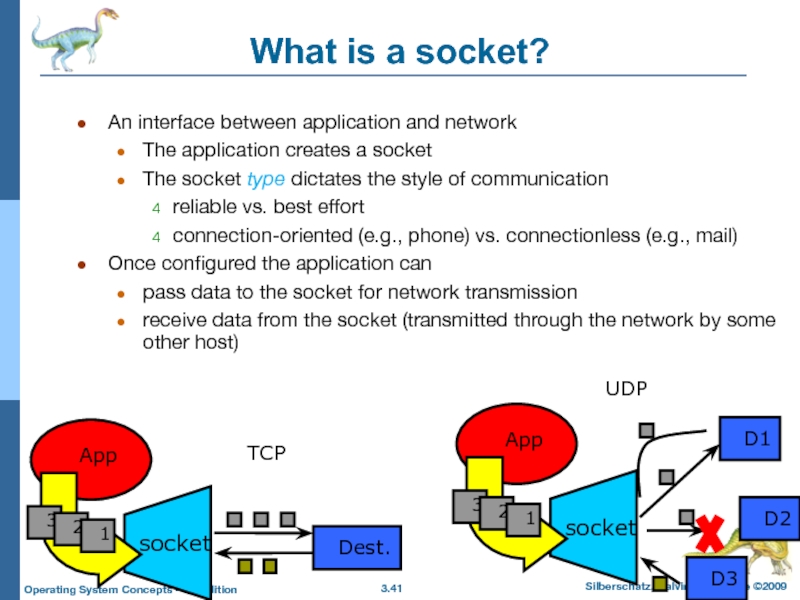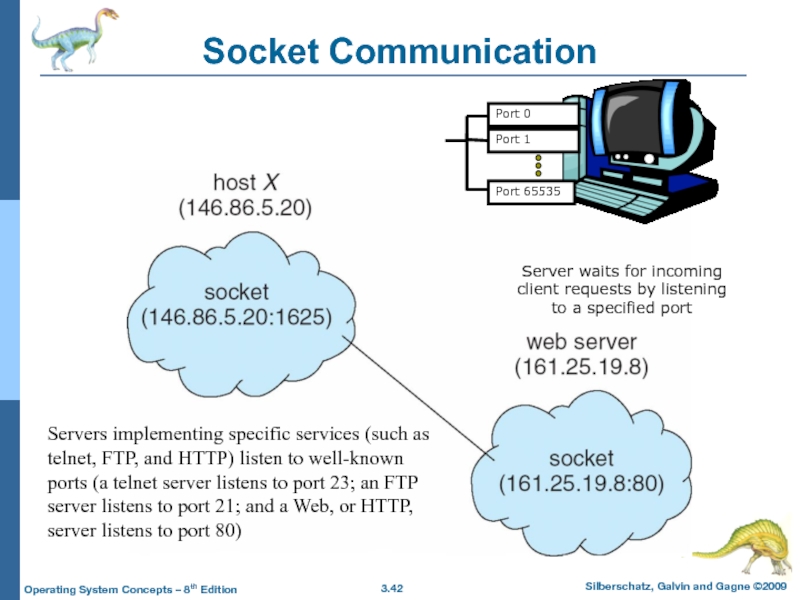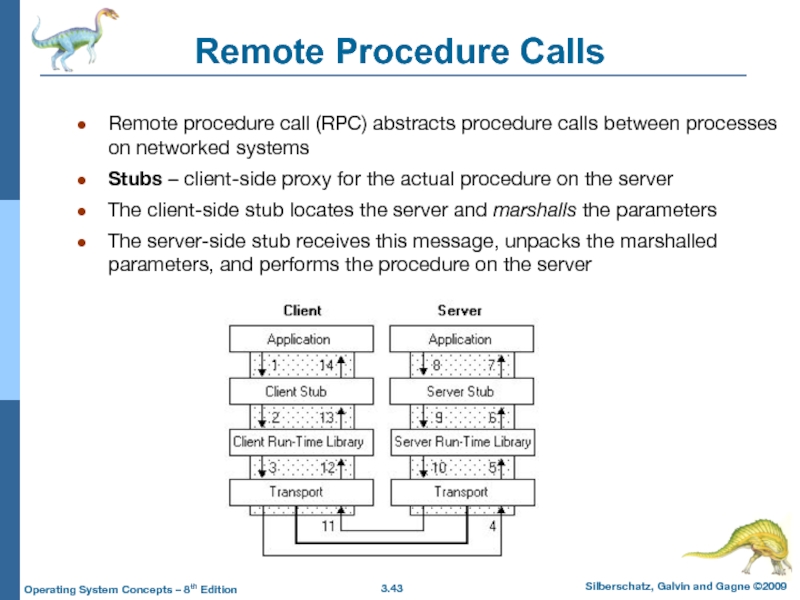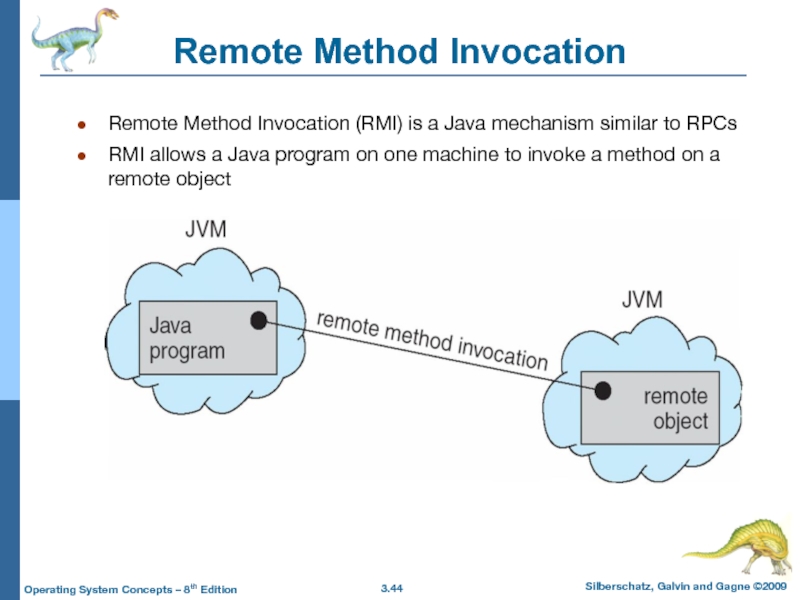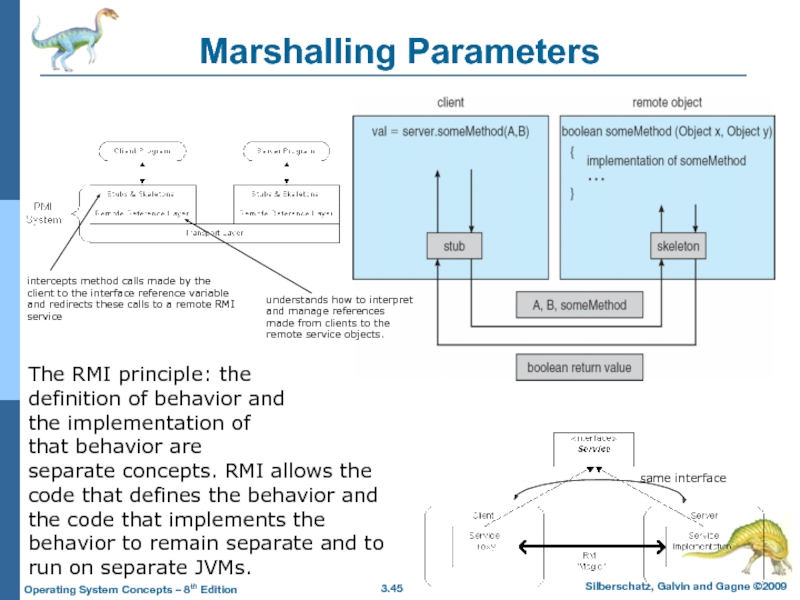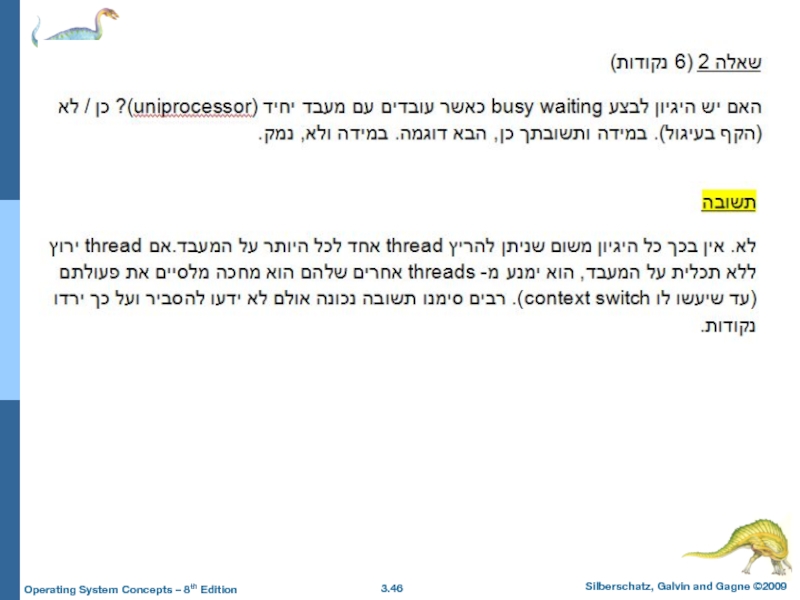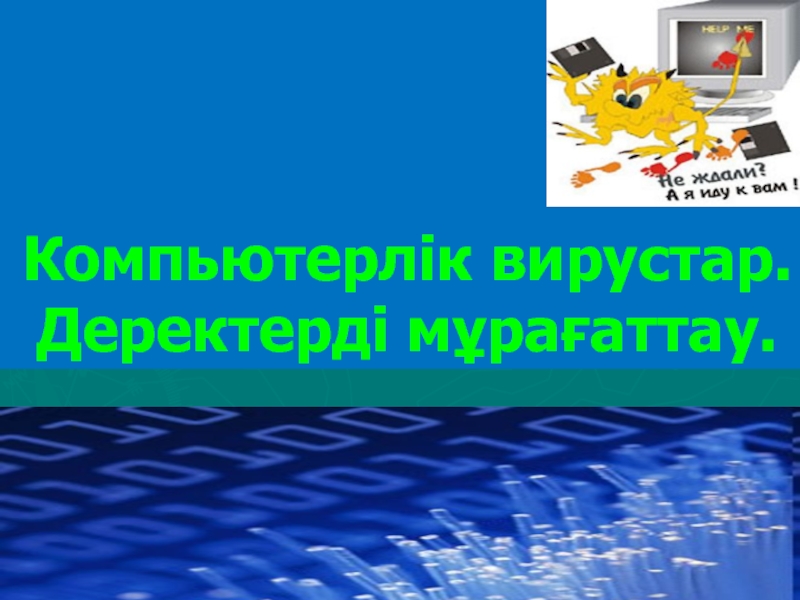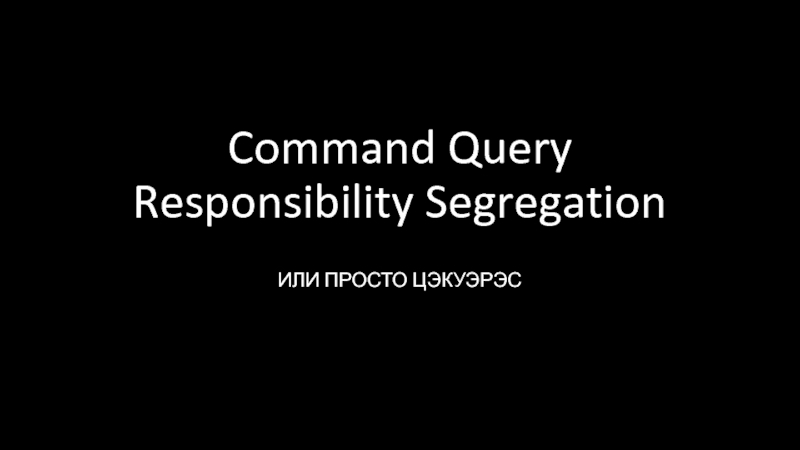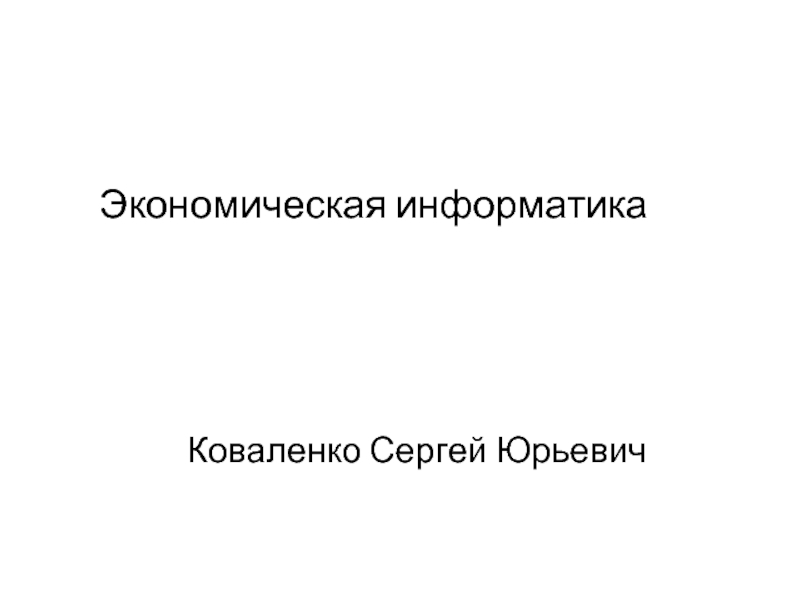- Главная
- Разное
- Дизайн
- Бизнес и предпринимательство
- Аналитика
- Образование
- Развлечения
- Красота и здоровье
- Финансы
- Государство
- Путешествия
- Спорт
- Недвижимость
- Армия
- Графика
- Культурология
- Еда и кулинария
- Лингвистика
- Английский язык
- Астрономия
- Алгебра
- Биология
- География
- Детские презентации
- Информатика
- История
- Литература
- Маркетинг
- Математика
- Медицина
- Менеджмент
- Музыка
- МХК
- Немецкий язык
- ОБЖ
- Обществознание
- Окружающий мир
- Педагогика
- Русский язык
- Технология
- Физика
- Философия
- Химия
- Шаблоны, картинки для презентаций
- Экология
- Экономика
- Юриспруденция
Operating system. Processes презентация
Содержание
- 1. Operating system. Processes
- 4. Introduction מערכות המחשב (ומערכות ההפעלה) הראשונות: אפשרו
- 5. מטרות השיעור להציג את ה"תהליך" (process) –
- 6. Process Concept בקורס נשתמש במושגים job ו-
- 7. Process in Memory Usually temporary data (such
- 8. Program and Process על-בסיס אותה תוכנית ניתן
- 9. Process State במהלך ריצתו משנה התהליך את
- 10. Diagram of Process State
- 11. Process Control Block (PCB) Information associated with
- 12. CPU Switch From Process to Process
- 13. Process Scheduling Queues המטרה – שבכל עת
- 14. Ready Queue And Various I/O Device Queues
- 15. Representation of Process Scheduling Queuing Diagram Wait
- 16. Schedulers Long-term scheduler (or job scheduler) –
- 17. Schedulers (Cont) ה- short-term scheduler נכנס לפעולה
- 18. Schedulers (Cont) תהליכים מאופיינים כ: I/O bound
- 19. Context Switch כאשר המעבד עובר לטפל בתהליך
- 21. Process Creation Creating a process – using
- 22. Process Creation (Cont) Execution Parent and children
- 23. Process Creation
- 24. C Program Forking Separate Process int main()
- 25. Process Termination בסיום פעולתו נדרש התהליך להריץ
- 26. Interprocess Communication תהליכים צריכים דרך לחלוק ולשתף
- 27. Communications Models Better for exchanging small
- 28. Producer-Consumer Problem Paradigm for cooperating processes, producer
- 29. Bounded-Buffer – Shared-Memory Solution Shared data #define
- 30. Bounded-Buffer – Producer while (true) {
- 31. Bounded Buffer – Consumer while (true) {
- 32. Interprocess Communication – Message Passing מהווה מכאניזם
- 33. Direct Communication Processes must name each other
- 34. Indirect Communication Messages are directed and received
- 35. Indirect Communication Operations create a new mailbox
- 36. Indirect Communication Mailbox sharing P1, P2, and
- 37. Synchronization מנגנון ה- message passing יכול להיות
- 38. Buffering Whether direct or indirect, messages must
- 39. Communications in Client-Server Systems Sockets Remote Procedure Calls Remote Method Invocation (Java)
- 40. Sockets A socket is defined as an
- 41. What is a socket? An interface between
- 42. Socket Communication Server waits for incoming client
- 43. Remote Procedure Calls Remote procedure call (RPC)
- 44. Remote Method Invocation Remote Method Invocation (RMI)
- 45. Marshalling Parameters The RMI principle: the
Слайд 4Introduction
מערכות המחשב (ומערכות ההפעלה) הראשונות:
אפשרו הרצת תכנית אחת (בלבד) בו זמנית
לתכנית
כיום:
מאפשרות העלאה לזיכרון והרצה של מספר תכניות לזיכרון והרצה במקביל
מחייב שליטה הדוקה יותר של מערכת ההפעלה
Слайд 5מטרות השיעור
להציג את ה"תהליך" (process) – תוכנית בהרצה (program in execution),
לתאר מספר מאפיינים (features) של תהליכים, ובכלל זה תזמון (scheduling), יצירה (creation), עצירה (termination) ותקשורת (communication)
Слайд 6Process Concept
בקורס נשתמש במושגים job ו- process כחליפיים
Jobs – בד"כ מתייחס
Process – בד"כ למערכות שהן time-shared
התהליכים הרצים במערכת:
תהליכים של מערכת ההפעלה המריצים system code
תהליכים של המשתמש המריצים user code
Process – "תוכנית בהרצה":
Program (executable) – ישות פאסיבית השוכנת על הדיסק
Process – ישות אקטיבית אשר משנה באופן רצוף את מצבה
הרצת התהליך מתבצעת בצורה סדרתית (sequential)
התהליך כולל:
program counter
Stack and heap
Text and data section
Слайд 7Process in Memory
Usually temporary data (such as function parameters, return addresses,
Dynamically allocated during process run-time
Global variables
compiled code of the program
Слайд 8Program and Process
על-בסיס אותה תוכנית ניתן להריץ שני תהליכים או יותר
Program
program counter
program counter
Difference in size and content
Difference in size and content
Difference content
Слайд 9Process State
במהלך ריצתו משנה התהליך את מצבו (state):
new: The process is
running: Instructions are being executed
waiting: The process is waiting for some event to occur (e.g., I/O completion)
ready: The process is waiting to be assigned to a processor
terminated: The process has finished execution
momentary states
שמות המצבים (states) המפורטים בשקף משתנים ממערכת למערכת
כמה תהליכים יכולים להיות במערכת בכל רגע נתון בכל state?
Слайд 11Process Control Block (PCB)
Information associated with each process
Process state
Program counter –
CPU registers
CPU scheduling information – e.g., process priority, pointers to scheduling queues
Memory-management information – value of base and limit registers, page or segment tables
Accounting information
I/O status information – list of open files, I/O devices allocated to the process
Слайд 13Process Scheduling Queues
המטרה – שבכל עת יהיה תהליך שיכול לרוץ על
למטרה זו נשתמש ב- Process scheduler
תורים בהם נעשה שימוש:
Job queue – סט כל התהליכים שבמערכת (לתור זה מגיעים כל התהליכים מיד עם יצירתם)
Ready queue – סט כל התהליכים אשר: א) נמצאים בזיכרון; ב) ממתינים להרצה
Device queues – סט התהליכים הממתינים ל- I/O device
במהלך הרצתו עובר התהליך בין התורים השונים
Слайд 15Representation of Process Scheduling
Queuing Diagram
Wait for the child to finish execution
Why
Слайд 16Schedulers
Long-term scheduler (or job scheduler) – selects which processes should be
Short-term scheduler (or CPU scheduler) – selects which process should be executed next (from the ready queue) and allocates CPU
Слайд 17Schedulers (Cont)
ה- short-term scheduler נכנס לפעולה בצורה תדירה (כל מספר מילישניות):
חייב
עושה שימוש בשיטות יחסית פשוטות כמו FCFS, priority scheduling
ה- long term scheduler:
מופעל בתדירות נמוכה יותר (כל כמה שניות או דקות) ולכן פעולתו יכולה להיות ארוכה יותר (מנגנונים יותר מתוחכמים)
שולט על ה- degree of multiprogramming (מספר התהליכים בזיכרון)
Слайд 18Schedulers (Cont)
תהליכים מאופיינים כ:
I/O bound – מבלים את רוב זמנם בפעולות
CPU bound – מבלים את רוב זמנם בתהליכים חישוביים (ארוכים ומעטים) – למשל חישוב פאי (אם יקבלו מעבד פי שתיים יותר מהיר יסיימו במחצית מהזמן)
ה- long term scheduler צריך לדאוג שבכל רגע יהיה בזיכרון מיקס של תהליכי I/O-bound ו- CPU-bound:
מה יקרה ל- ready queue ו- I/O queues כאשר:
כל התהליכים הם I/O bound?
כל התהליכים הם CPU-bound?
Слайд 19Context Switch
כאשר המעבד עובר לטפל בתהליך אחר, המערכת חייבת לשמור את
ה- context של תהליך מיוצג על-ידי ושמור ב- PCB
זמן ביצוע ה- context switch הוא overhead שכן המערכת איננה מבצעת עבודה שמשמשת את המשתמש
משך זמן ביצוע ה- context switch מושפע מהתמיכה בחומרה:
E.g., Sun UltraSPARC provides multiple sets of registers
Слайд 21Process Creation
Creating a process – using create process system call
Parent process
Generally, process identified and managed via a process identifier (pid)
Resource sharing (cpu time, memory, I/O devices)
Parent and children share all resources
Children share subset of parent’s resources
Parent and child share no resources
One process can overload the system by creating many processes
Initialization data is passed from parent to child upon creation
A tree of processes on a typical Solaris
Memory mng.
File system mng.
Root parent process for all user processes
Network services
Слайд 22Process Creation (Cont)
Execution
Parent and children execute concurrently
Parent waits until children terminate
Address
Child duplicate of parent – same program and data
Child has a program loaded into it
UNIX examples
fork system call creates new process
Parent’s address space is duplicated
Both processes resume execution at the instruction after the fork()
exec system call used after a fork to replace the process’ memory space with a new program
Wait() – takes the process out the ready queue until the child process terminates
Слайд 24C Program Forking Separate Process
int main()
{
pid_t pid;
/* fork another process */
pid
if (pid < 0) { /* error occurred */
fprintf(stderr, "Fork Failed");
exit(-1);
}
else if (pid == 0) { /* child process */
execlp("/bin/ls", "ls", NULL);
}
else { /* parent process */
/* parent will wait for the child to complete */
wait (NULL);
printf ("Child Complete");
exit(0);
}
}
Слайд 25Process Termination
בסיום פעולתו נדרש התהליך להריץ את הפקודה exit:
מערכת ההפעלה מוחקת
משאבי התהליך מוחזרים למ"ה לצורך הקצאה מחדש
אם התהליך הוא תהליך בן אז (במידת הצורך) מועבר output לתהליך האב (via wait)
תהליך אב יכול לגרום להפסקת פעולת תהליך בן (abort), לדוגמה במקרים:
תהליך הבן משתמש ביותר משאבים ממה שהוקצו לו
המשימה שלשמה נוצר תהליך הבן הסתיימה או שאינה נדרשת עוד
תהליך האב עצמו סיים את פעולתו:
בחלק ממערכות ההפעלה לא ניתן להשאיר תהליך רץ כאשר תהליך האב מסתיים – במקרה כזה עושים cascading termination
Слайд 26Interprocess Communication
תהליכים צריכים דרך לחלוק ולשתף מידע ביניהם:
בין שרצים באותה מערכת
התמיכה בשיתוף מידע היא באמצעות IPC (interprocess communication)
שני מודלים של IPC:
Shared memory – usually resides in the address space of creating process
Message passing
Слайд 27Communications Models
Better for exchanging small messages (no conflicts need to
Easier to implement
Faster
Слайд 28Producer-Consumer Problem
Paradigm for cooperating processes, producer process produces information that is
Shared memory solution:
unbounded-buffer places no practical limit on the size of the buffer (producer never waits)
bounded-buffer assumes that there is a fixed buffer size
Слайд 29Bounded-Buffer – Shared-Memory Solution
Shared data
#define BUFFER_SIZE 10
typedef struct {
. . .
}
item buffer[BUFFER_SIZE];
int in = 0;
int out = 0;
Слайд 30Bounded-Buffer – Producer
while (true) {
/* Produce an item */
; /* do nothing -- no free buffers */
buffer[in] = item;
in = (in + 1) % BUFFER SIZE;
}
Слайд 31Bounded Buffer – Consumer
while (true) {
while
; // do nothing -- nothing to consume
// remove an item from the buffer
item = buffer[out];
out = (out + 1) % BUFFER SIZE;
return item;
}
Слайд 32Interprocess Communication – Message Passing
מהווה מכאניזם לתקשורת וסנכרון בין תהליכים
הרעיון הוא
ה- IPC facility מספק שתי פעולות:
send(message)
receive(message)
אם P ו- Q רוצים לתקשר ביניהם עליהם:
לייצר communication link ביניהם
להעביר הודעות באמצעות פקודות send/receive
מימוש ה- communication link הוא באמצעות חומרה (shared memory, hardware bus וכו')
Слайд 33Direct Communication
Processes must name each other explicitly:
send (P, message) – send
receive(Q, message) – receive a message from process Q
Properties of communication link
Links are established automatically
A link is associated with exactly one pair of communicating processes
Between each pair there exists exactly one link
The link may be unidirectional, but is usually bi-directional
Main disadvantage:
Changing the identifier of a process result with many changes in the communication scheme
Слайд 34Indirect Communication
Messages are directed and received from mailboxes (also referred to
Each mailbox has a unique id
Processes can communicate only if they share a mailbox
Primitives are defined as:
send(A, message) – send a message to mailbox A
receive(A, message) – receive a message from mailbox A
Properties of communication link
Link established only if processes share a common mailbox
A link may be associated with many processes
Each pair of processes may share several communication links
Link may be unidirectional or bi-directional
Слайд 35Indirect Communication
Operations
create a new mailbox
send and receive messages through mailbox
destroy a
Слайд 36Indirect Communication
Mailbox sharing
P1, P2, and P3 share mailbox A
P1, sends; P2
Who gets the message?
Solutions
Allow a link to be associated with at most two processes
Allow only one process at a time to execute a receive operation
Allow the system to select arbitrarily the receiver. Sender is notified who the receiver was
Alternatively – define an algorithm for selecting which process will receive the message (e.g., round robin)
Слайд 37Synchronization
מנגנון ה- message passing יכול להיות מאופיין כ- blocking or non-blocking
תצורת
Blocking send – השולח מבצע block עד שההודעה מתקבלת
Blocking receive – המקבל מבצע block עד שההודעה זמינה לקבלה
תצורת non-blocking נחשבת תצורה א-סינכרונית:
Non-blocking send – השולח שולח את ההודעה וממשיך בפעולתו
Non-blocking receive – המקבל מקבל את ההודעה גם אם היא invalid או null
Слайд 38Buffering
Whether direct or indirect, messages must reside in a queue; implemented
1. Zero capacity – no messages can wait in queue. Sender must block until recipient receives the message Sender must wait for receiver (rendezvous)
2. Bounded capacity – finite length of n messages Sender must wait if link full
3. Unbounded capacity – infinite length Sender never waits
Слайд 39Communications in Client-Server Systems
Sockets
Remote Procedure Calls
Remote Method Invocation (Java)
Слайд 40Sockets
A socket is defined as an endpoint for communication
Concatenation of IP
The socket 161.25.19.8:1625 refers to port 1625 on host 161.25.19.8
Communication consists between a pair of sockets
Слайд 41What is a socket?
An interface between application and network
The application creates
The socket type dictates the style of communication
reliable vs. best effort
connection-oriented (e.g., phone) vs. connectionless (e.g., mail)
Once configured the application can
pass data to the socket for network transmission
receive data from the socket (transmitted through the network by some other host)
TCP
UDP
Слайд 42Socket Communication
Server waits for incoming client requests by listening to a
Servers implementing specific services (such as telnet, FTP, and HTTP) listen to well-known ports (a telnet server listens to port 23; an FTP server listens to port 21; and a Web, or HTTP, server listens to port 80)
Слайд 43Remote Procedure Calls
Remote procedure call (RPC) abstracts procedure calls between processes
Stubs – client-side proxy for the actual procedure on the server
The client-side stub locates the server and marshalls the parameters
The server-side stub receives this message, unpacks the marshalled parameters, and performs the procedure on the server
Слайд 44Remote Method Invocation
Remote Method Invocation (RMI) is a Java mechanism similar
RMI allows a Java program on one machine to invoke a method on a remote object
Слайд 45Marshalling Parameters
The RMI principle: the
definition of behavior and
the implementation
same interface
intercepts method calls made by the client to the interface reference variable and redirects these calls to a remote RMI service
understands how to interpret and manage references made from clients to the remote service objects.
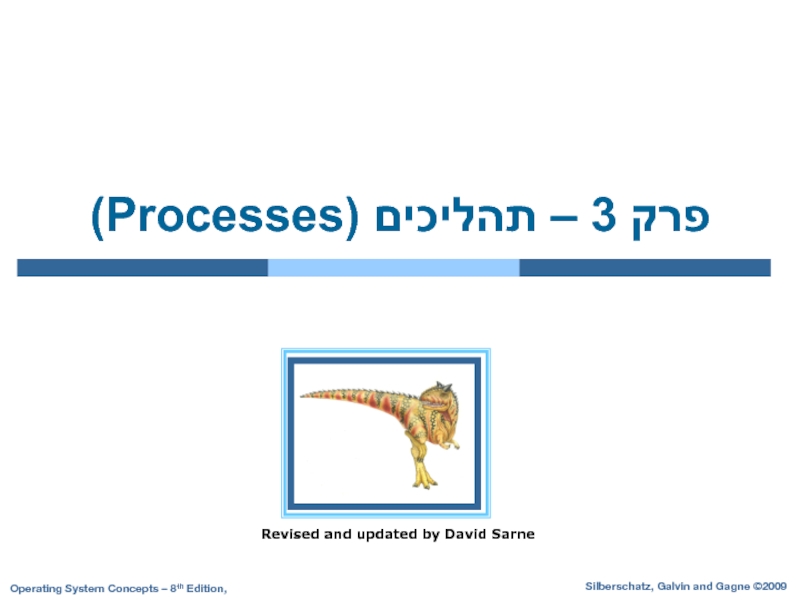
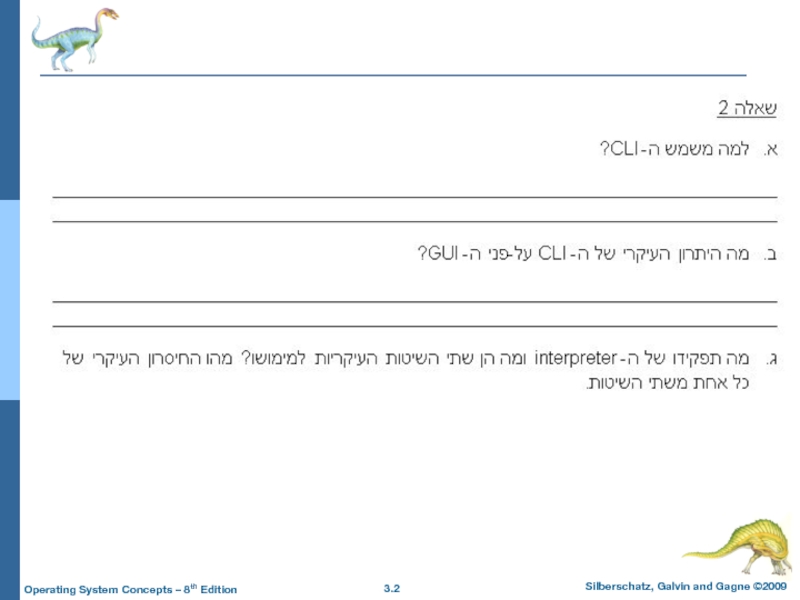
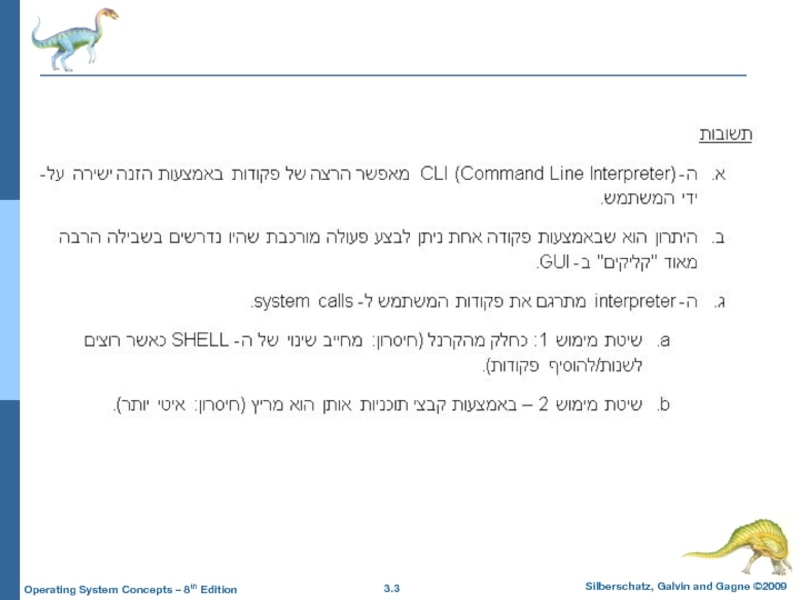
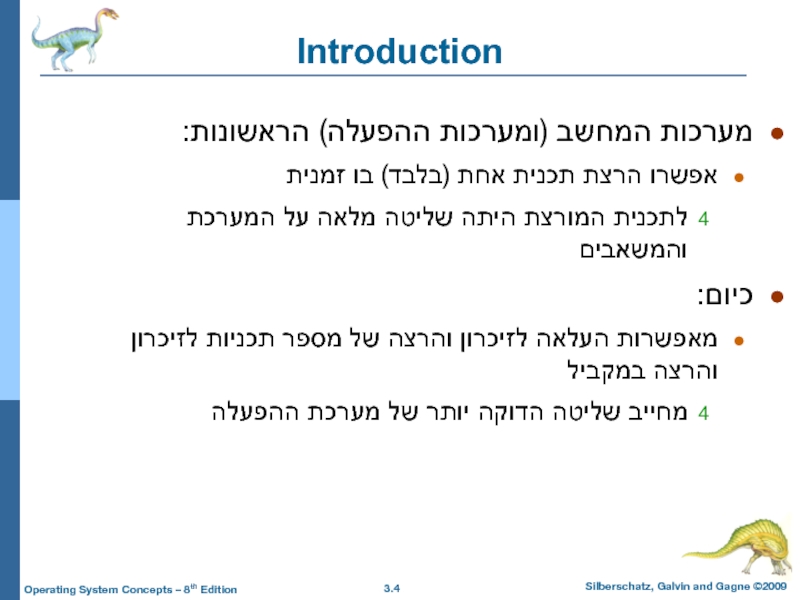
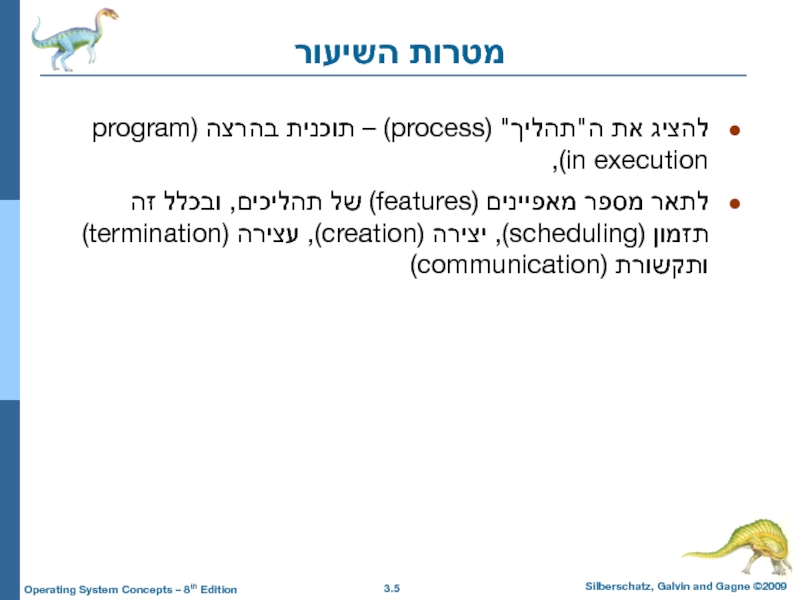
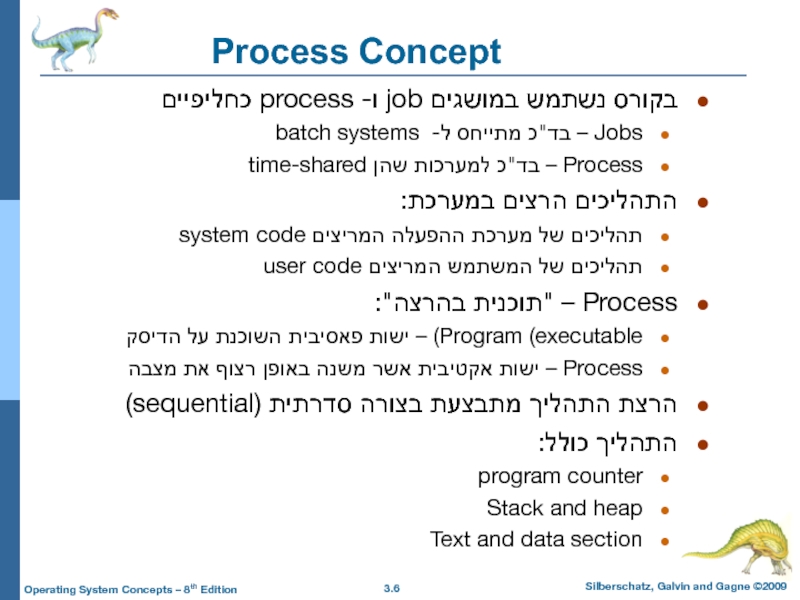
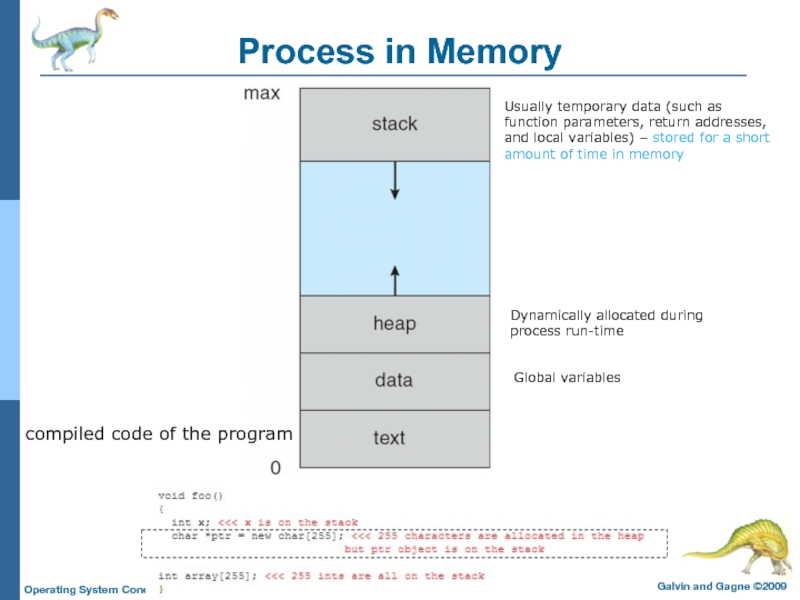
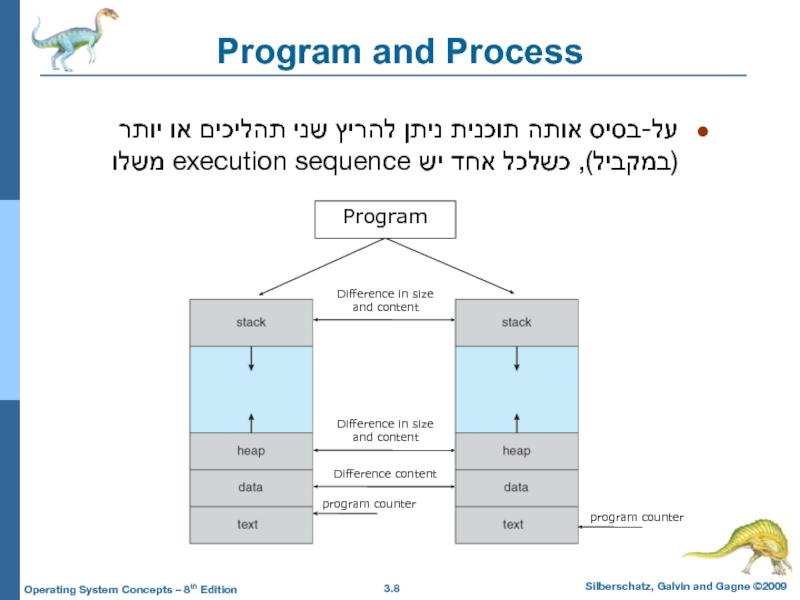
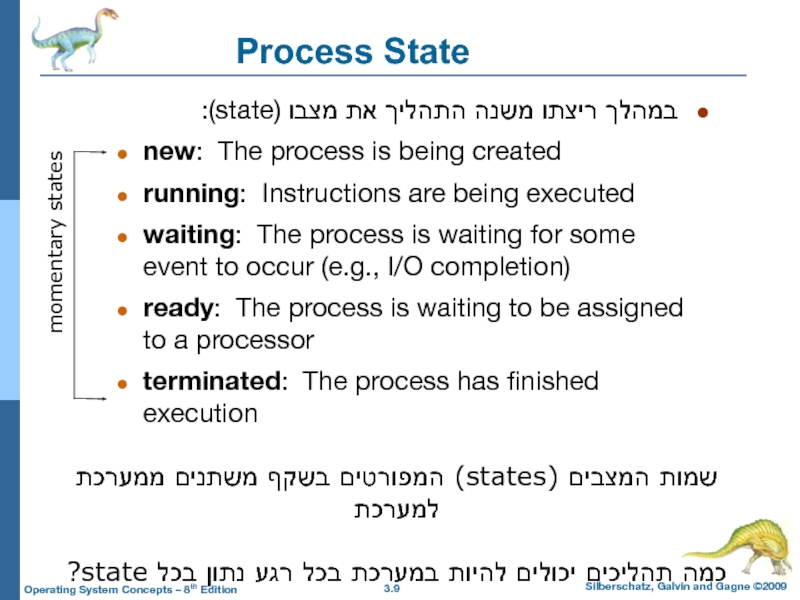

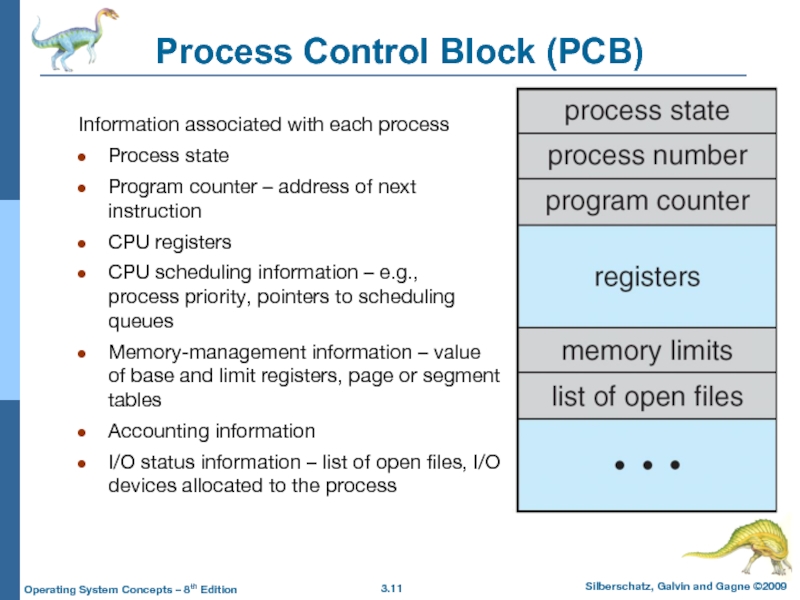
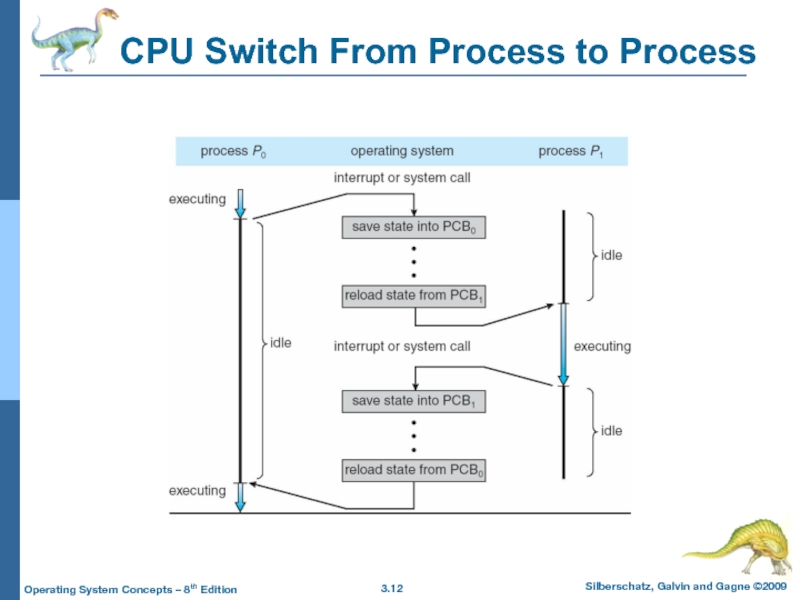
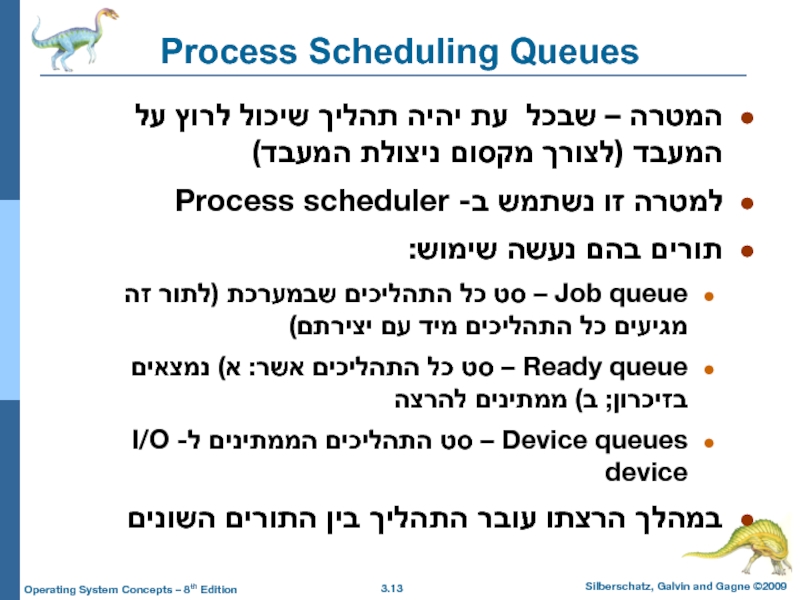
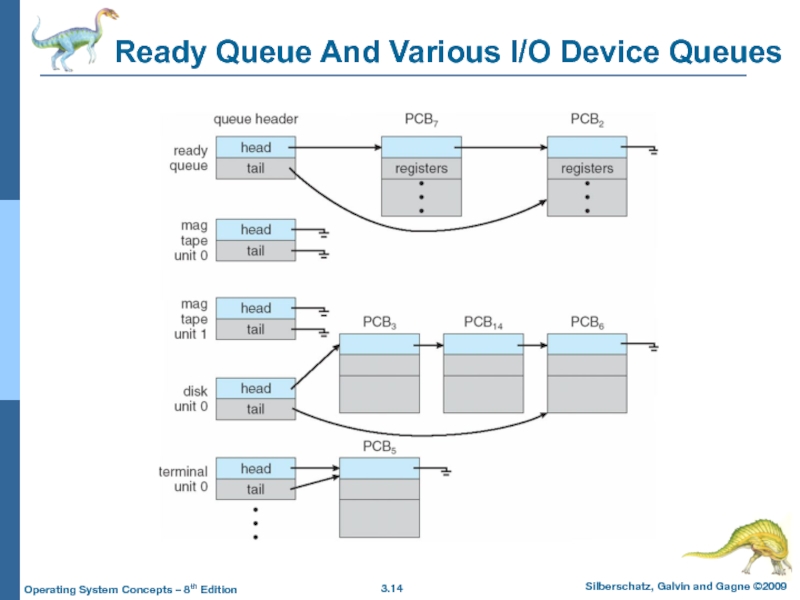
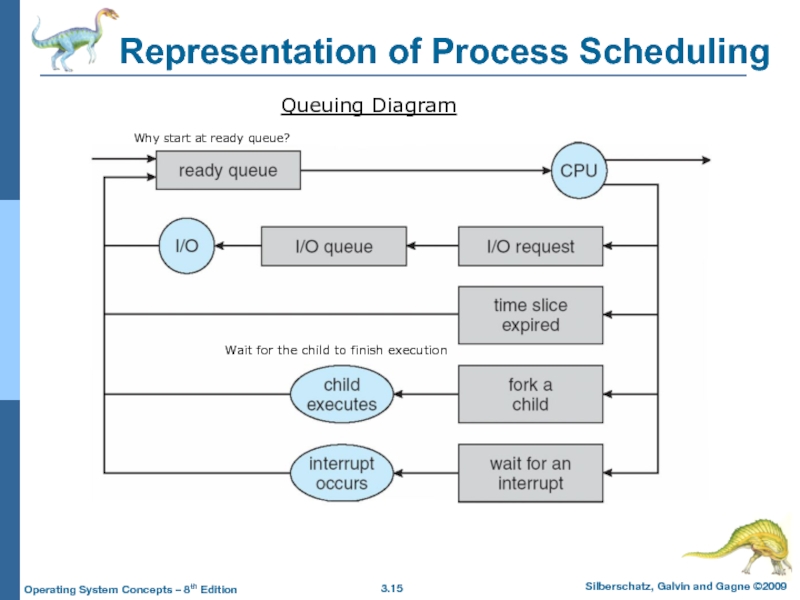
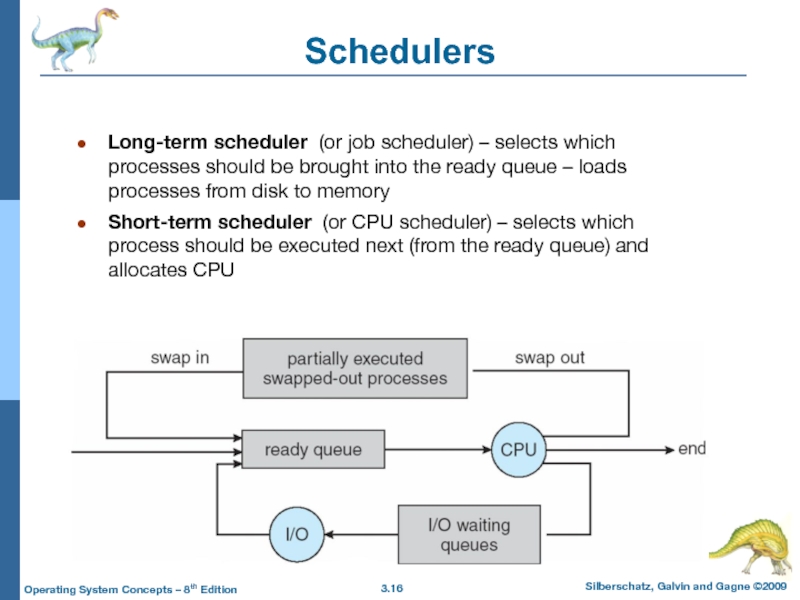
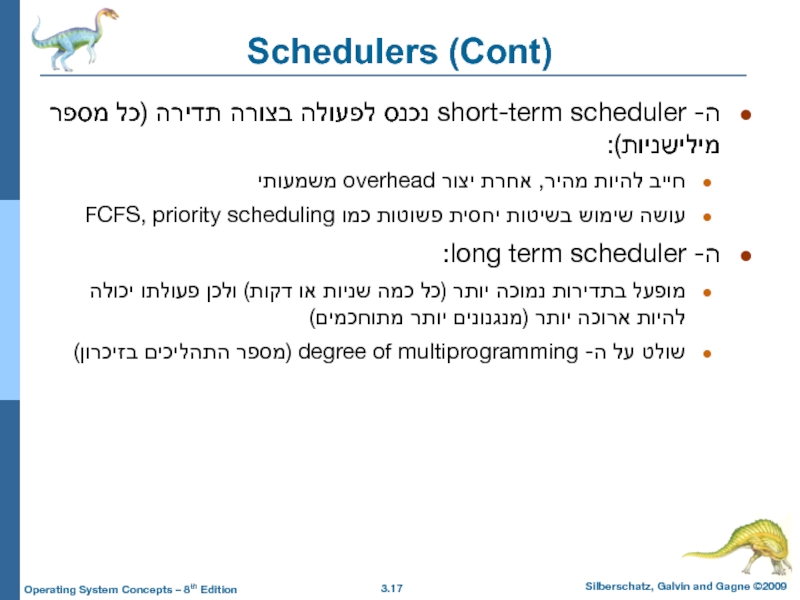
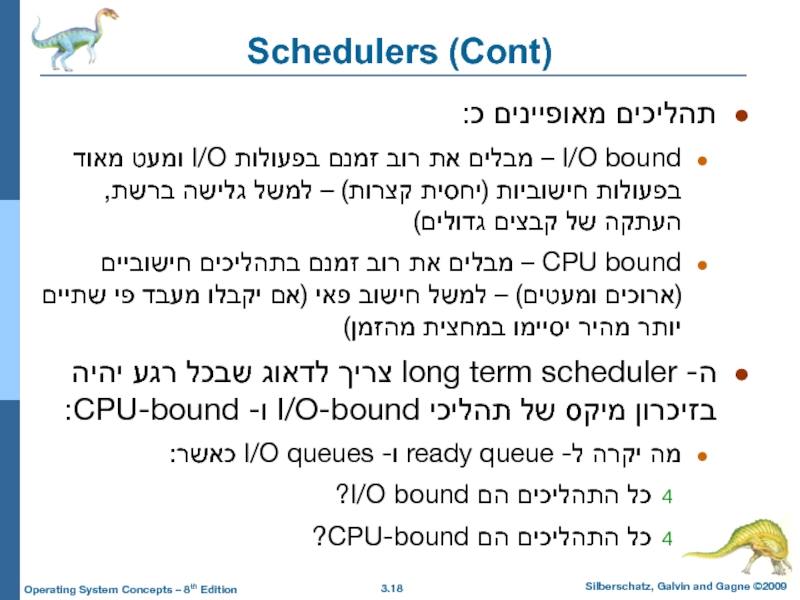
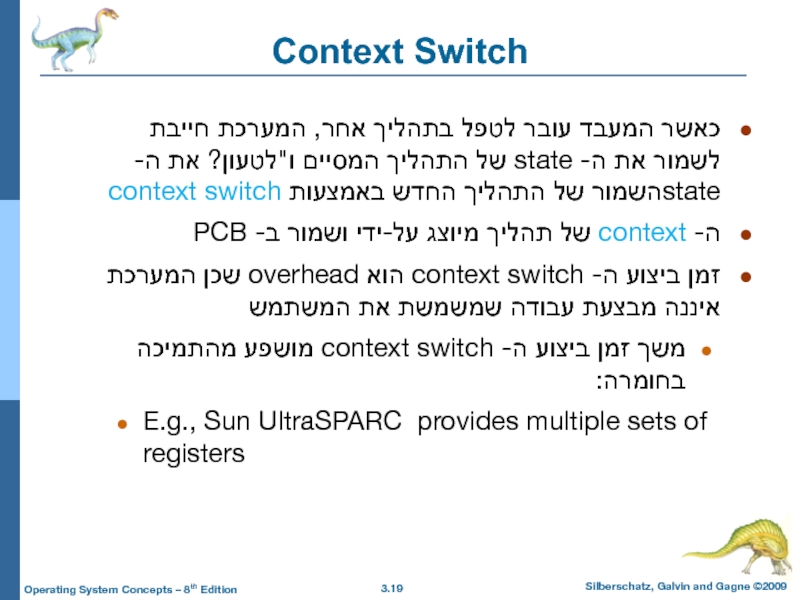
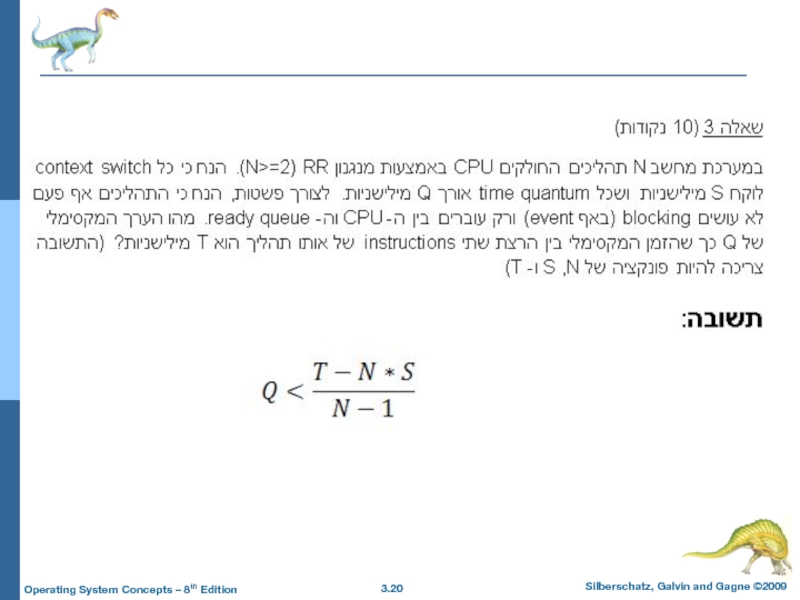
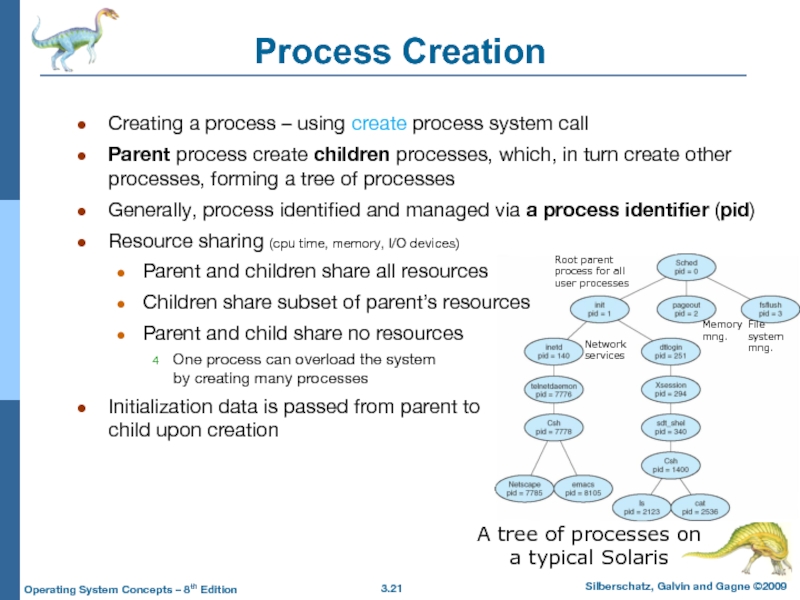
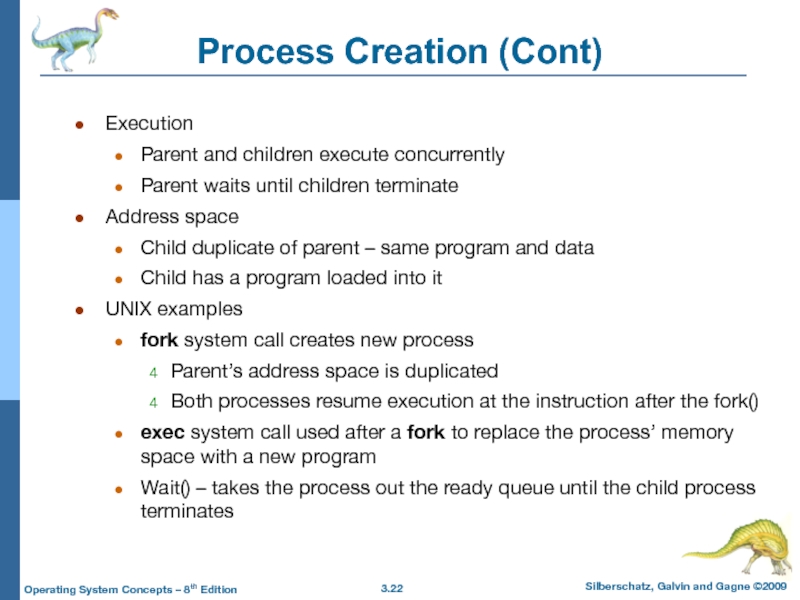
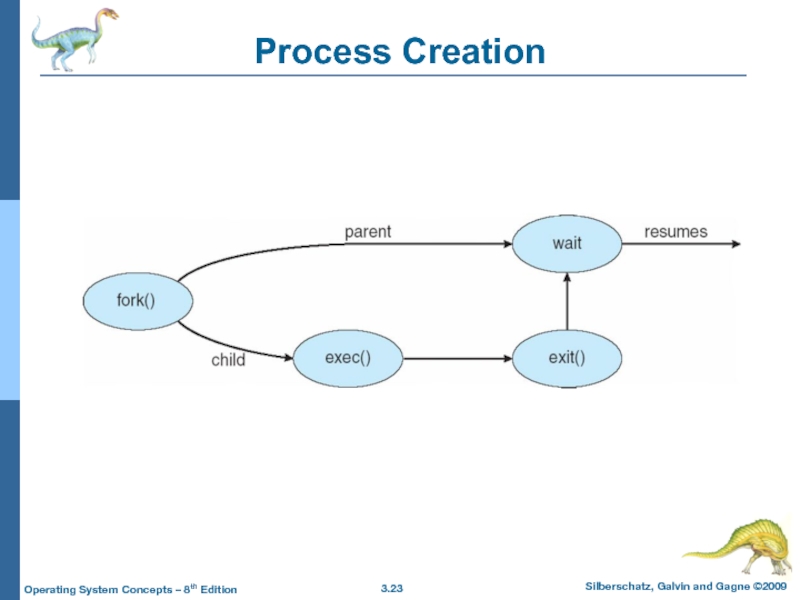
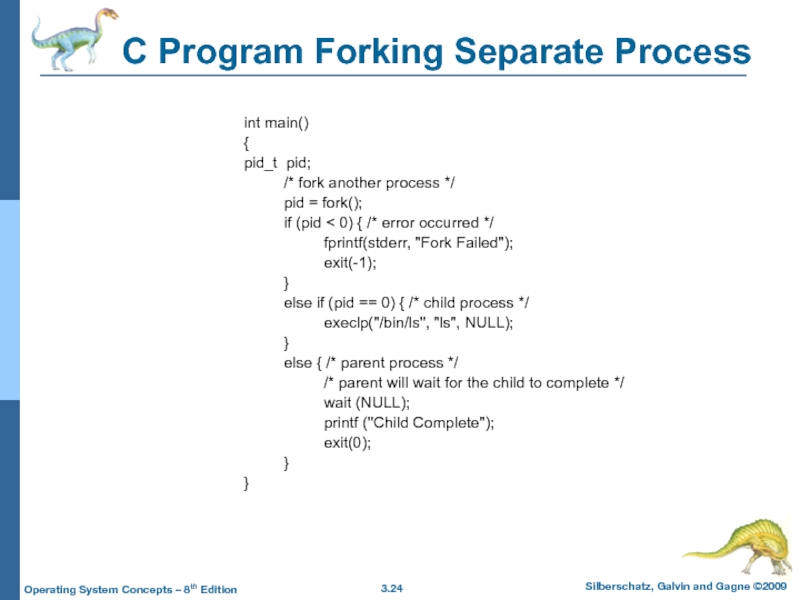
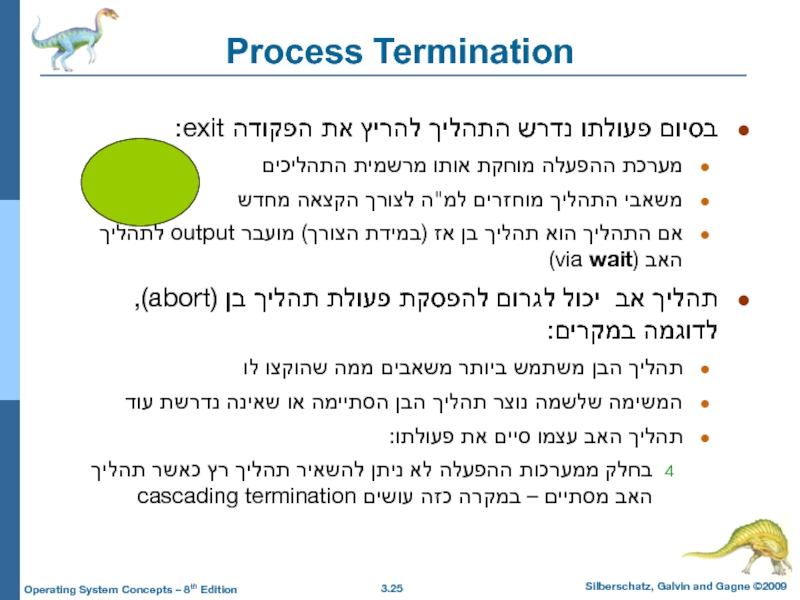
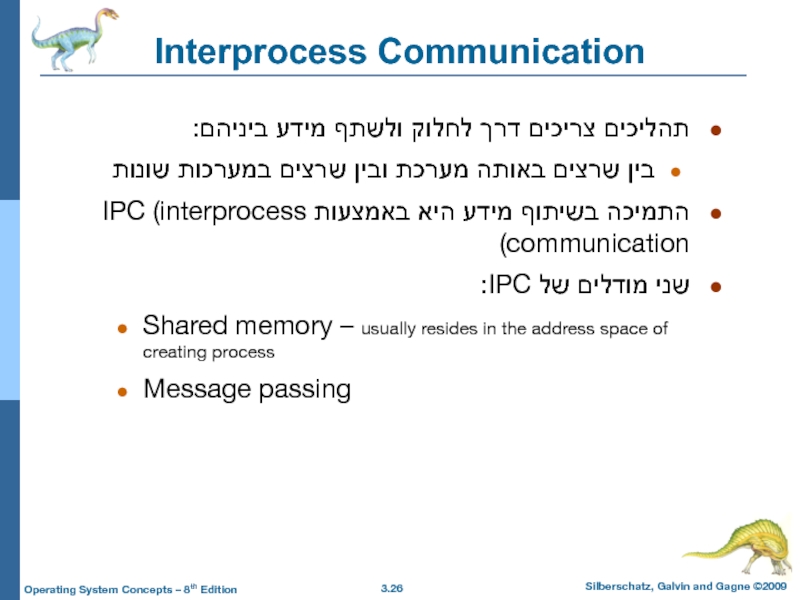
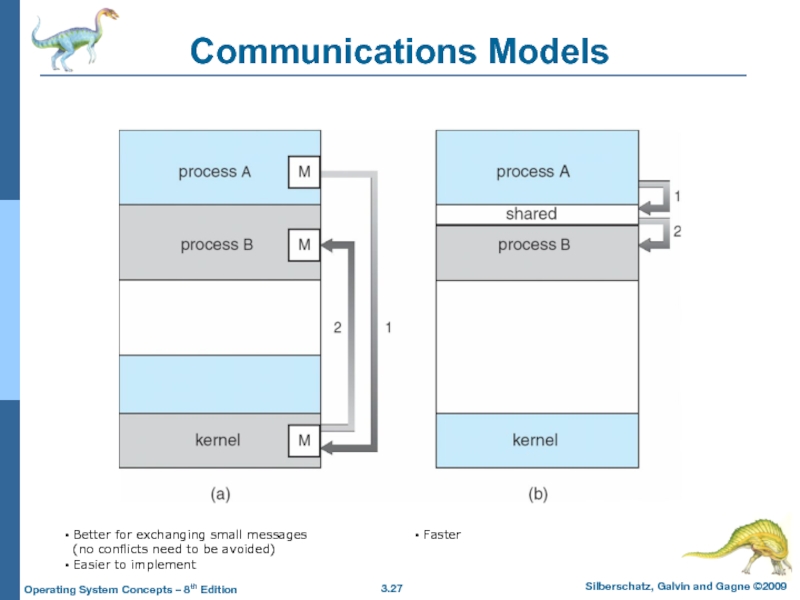
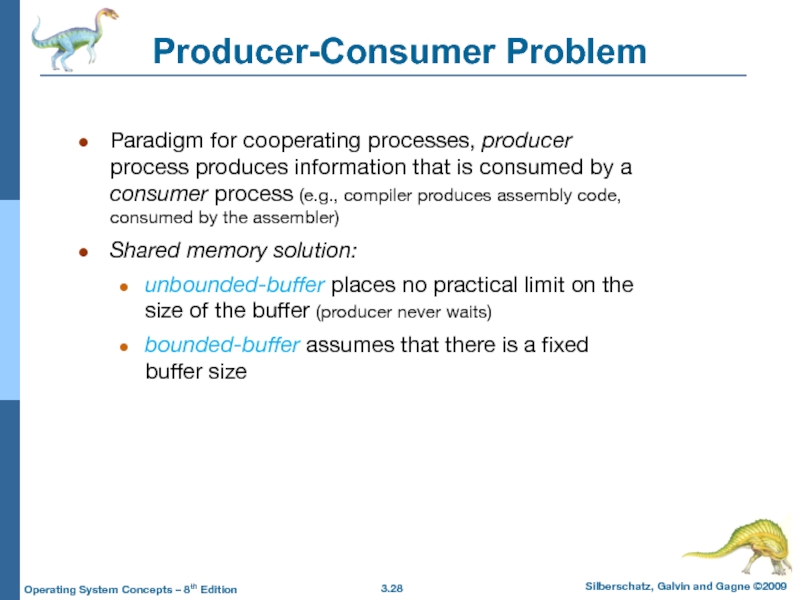
![Bounded-Buffer – Shared-Memory SolutionShared data#define BUFFER_SIZE 10typedef struct { . . .} item;item buffer[BUFFER_SIZE];int in =](/img/tmb/3/251065/c64f6a77abf6cd1846079d98926f712d-800x.jpg)
